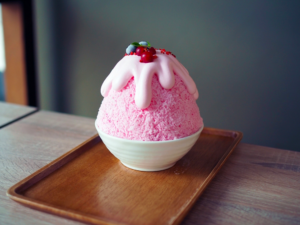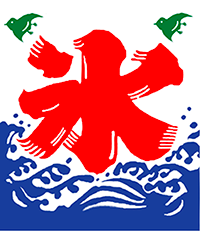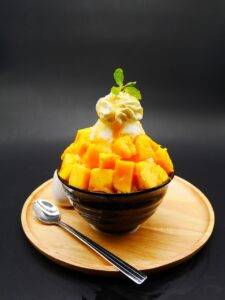Kakigori, a popular shaved ice dessert in Japan, has been a popular summer treat for centuries. This refreshing dessert is made by grating blocks of ice and adding sweet syrup and various toppings. But where does this delicious frozen treat come from? In this article, we take a look at the history of Kakigori.

The origins
Kakigori has its origins in the Heian period (794-1185) in Japan. Because the ice had to be kept in a special storage area, only the very privileged could enjoy it.
Kakigori in the modern era
Over the centuries, Kakigori has become popular with the Japanese.
The ice cream was mainly imported from the United States. But in 1871, a café on the island of Hokkaido became very famous for its better-quality, cheaper natural ice.
The great craze created by Kakigori attracted many illegal ice-cream traders. In order to regulate the sale of Kakigori, the government decided in 1878 to create a licence supplied only to ice-cream producers who had passed a quality test. This licence was symbolised by the sign opposite.
The licensing system has changed, but the signs are still widely used in the various cafés serving Kakigori.

In 1883, the first major ice cream company was created following the successful development of freezing technology.
In Japan, the first Kakigori machines were manual instruments, consisting of a block of ice fixed to a wooden plate and a blade for grating it. The patent for the very first Kakigori machine was registered in 1887. Over time, Kakigori machines evolved to become more efficient and practical to use.
In the 1950s, electric Kakigori machines were invented, making it easier and more convenient to make. Modern machines are usually equipped with an electric motor, which allows the ice to be grated faster and with greater precision. Kakigori machines are available in a variety of sizes and models to meet the needs of different types of catering establishments, from small street stands to large department stores. You can find our different models directly on our website.

At the beginning of the 20th In the 19th century, ice cream became more widely available and Kakigori began to lose popularity.
However, during the Second World War, Japan experienced a severe shortage of foodstuffs, including ice cream. The Japanese government therefore decided to ration ice cream production to save the raw materials needed for the war effort. As a result, Kakigori became a popular alternative to ice cream, as the ingredients needed to make it were more readily available.
It was only after the Second World War that Kakigori began to be served with flavoured syrup. Before the war, it was served simply sprinkled with sugar, or sugar syrup and sweetened red azuki bean paste.
The Japanese began to turn to Kakigori as a refreshing and economical summer dessert, and it quickly became a favourite choice during this difficult period in Japan's history. In those days, Kakigori vendors would travel around the neighbourhoods selling their frozen treats from wooden carts.
The dessert has become even more popular, and is now a summer staple in Japan. It's easy to find on the streets of Japan, where you can buy it from street vendors.
Kakigori around the world
There are many types of Kakigori, often accompanied by various toppings such as fruit, sweetened condensed milk, mochi and even matcha powder. Some of the most popular flavours include strawberry, melon and green tea.
In recent years, Kakigori has also become popular outside Japan. In the United States and other parts of the world, Kakigori is often served in Japanese restaurants or at food festivals. New variations and flavours of Kakigori continue to emerge around the world.

Other Asian countries have variations of Kakigori. In the Philippines, for example, the halo-halo is a similar dessert made with crushed ice, sweetened condensed milk and various ingredients such as beans, fruit and tapioca. In Korea bingsu is a variant of Kakigori that often uses fresh fruit and sweet syrups to add flavour. In Taiwan, China, Vietnam and Malaysia, you'll find tshuah-ping made from fruit, syrup and condensed milk. In the West Indies snowball is simply ice cream and syrup. In conclusion, each country has its own variant of shaved ice, which is what makes it so popular around the world.
A profitable business
Although Kakigori is considered an affordable street snack in Japan, it can be a profitable business for vendors. Production costs are relatively low, as they generally consist of few ingredients.
Sellers can also sell premium flavours for a higher price, increasing their profit margin. What's more, the growing popularity of Kakigori outside Japan makes it a potentially lucrative product for entrepreneurs looking to get into the food business.
According to a weathernews.jp survey conducted in August 2022, people tend to prefer Kakigori over ice cream as the temperature rises, with 52% of people responding that they would opt for Kakigori over ice cream if the outside temperature is above 34°C.
Kakigori has a rich history spanning centuries and multiple cultures. This icy treat has stood the test of time. Whether you prefer Kakigori with sweetened condensed milk or fresh fruit (or both at the same time), there's no doubt that it's the perfect way to cool down on a hot day.
What's more, you can easily create new recipes, whether sweet or savoury!
If you're tempted by the Kakigori adventure, check out all our machines on our website. To find out about the differences between our three machines, download our Comparison of Kakigori machines.


